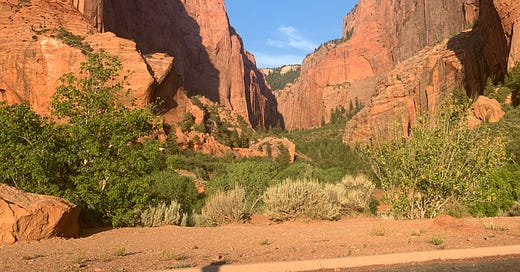I’d come to loathe the New York City skyline. The glistening images of its made-up face. Its promises of prosperity, modernity, happiness, its silver-plated redwoods planted in garbage and soot.
What was the allure of sky-kissed buildings, anyway? Dead, impermanent sheets of metal, built and maintained on the backs of workers. The “concrete jungle”—what a joke. Jungles were regenerative, self-sustaining, pure. This corrupt metal habitat was sustained by time and energy, by slavery, unhappiness, the wasting of lives. When a tree falls, it creates life. It decomposes, becomes part of the larger ecosystem. When a building falls, it kills.
I remember being far away from New York City, on vacation in Utah, staying the night at a ranch near Zion National Park. Relaxed after a long day, I sat facing the back-side of a famous canyon, enamored by the color gradients of the red rocks, their stripes of orange and tan. The desert bushes created sparse tuneful dotting of “cactus grey.” I could’ve stared at it for days. It was as though my soul lived in that rock, and was beckoning me home.
Home. Suddenly the peace of where I was became suddenly shadowed by the realization of where I would soon be. What natural marvels did I have back home? What famous landmarks of beauty? Facing me was a panoramic view of the history of the earth, each layer of rock telling a different story. Back “home,” our panoramic view was the skyline.
This wasn’t the first time that I had drawn begrudging comparisons between Zion and New York City. I was told that the rocks in the National Park were “as tall as skyscrapers.” Now, I’m used to being surrounded by magnificent heights—but this was different In the city, I’d never look up to the tops of the buildings. Why would I—I’d only be blinded by the glare of the sun reflecting off of the glass and then trampled by a rushing pedestrian. But the tops of those rocks were begging for my gaze. I looked up and they greeted me warmly, softly. I was in awe. Surely, these views could never get old. There’s too much history, too much depth crammed into one layer of rock. The wisdom of millions of years was contained in that canyon, distilled into the image of one mountain, an image I was lucky to behold. It is nature’s, well, nature to produce such images, and it dawned on me that before cities, all humans could gaze upon such things. An expensive luxury for me was my ancestors’ birthright.
I could stare at that same rock for decades and always see something new. That I was absolutely certain of, even though I had only been there for one night. But what of the skyline? That was another expensive luxury that people came from all over the world to see. Another awe-inspiring marvel that craned peoples’ necks and invigorated their spirits. I’m sure that those manmade Manhattan canyons had called people home, too—just as the rocks at Zion had done to me. Perhaps people traveling all the way from Utah, tired of looking at the same dumb rock every day and longing for the excitement and adventure of the city.
There’s a Ralph Waldo Emerson quote that I often think about:
“Nature who made the mason, made the house.”
Nature is all around us. Everything we see is nature. We are nature too. Does it not then follow that our creations are nature, also? There are two sides to every coin, a horror for every beauty. We are born and we must die, and death is ugly. A forest is as ruthless as it is tranquil. Focusing on the bloodshed, one could rightly characterize the untainted ocean a hellscape.
Could that be where humans go wrong, when criticizing our homelands? Are we misguidedly fixated on the cruel and ugly, when the good is just as apparent? Let’s consider a Henry David Thoreau quote:
“The question is not what you look at, but what you see.”
The cruel nature of our condition is to look past what is directly in front of us. Beaten and blinded by daily grinds and daily tedium, we breeze past spectacles in oblivion. Some of the most trite platitudes: “stop and smell the roses,” “the grass is greener on the other side,” contain within them the utmost truth. The grass is greener on the other side because that is where we bother to look. We don’t know what color grass we are standing on. Is it not ironic that we overlook these sayings, miss their meaning as surely as we miss the color of the grass right under our feet?
I don’t loathe the skyline anymore. I see its ugliness. I’m grateful for this—to not see the evil around you is to be blind, naive. But overlooking beauty is blindness, too, and perhaps an even deadlier breed in our safe, sterile world. And it is overwhelmingly beautiful to look across the East River at nightfall and watch the concrete behemoths open their glass eyes as the sky slumbers.
Humans are a remarkable species. We engineered buildings that touch the sky, a feat of biblical proportions. We’ve made a space where millions of people can coexist, a functioning ecosystem of our own creation. Yes, what we’ve created has a dark side. So do oceans and jungles. If we forgive God for the dark side of his creations, why not extend this kindness to ourselves?



